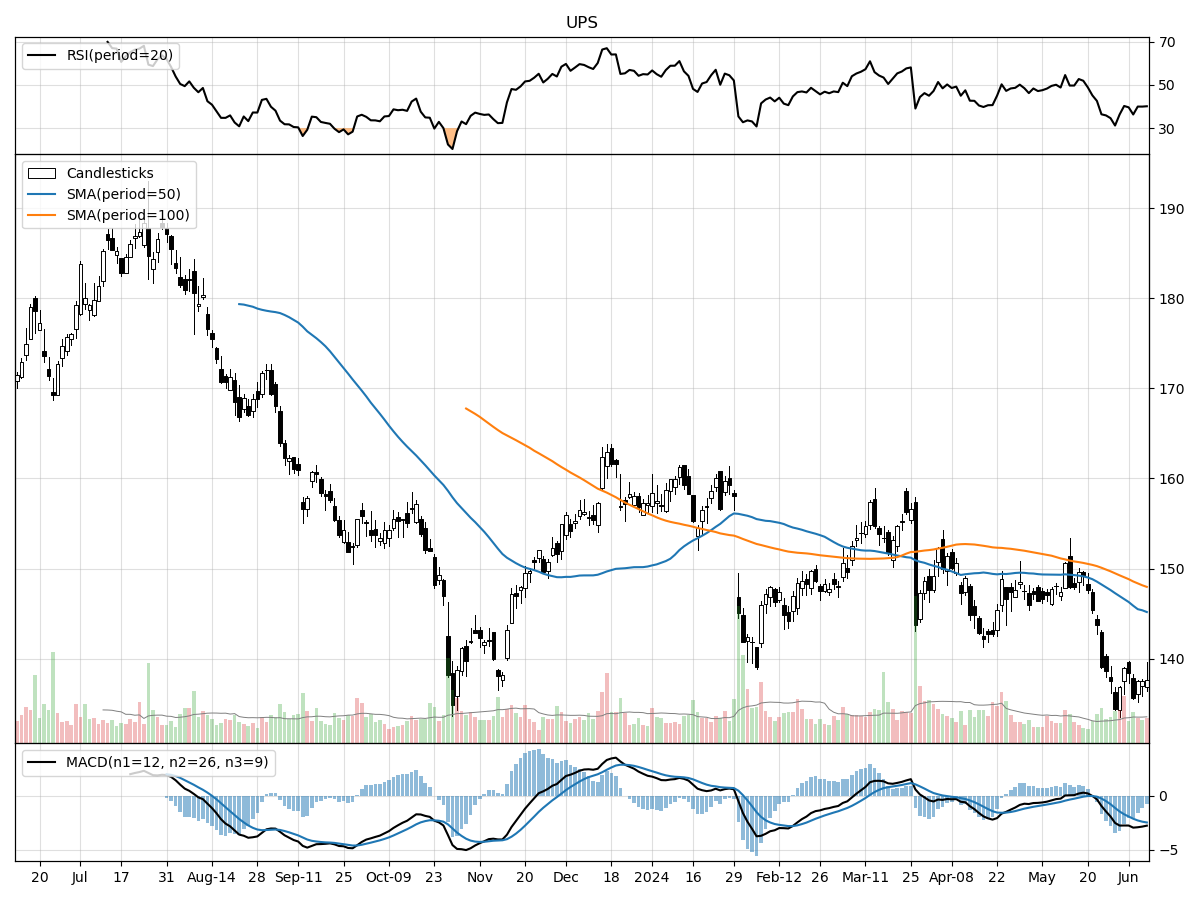United Parcel Service (UPS), Large Cap AI Study of the Week

June 11, 2024
Weekly AI Pick from the S&P 500
Company Overview
United Parcel Service, Inc. (UPS), established in 1907, is a premier package delivery and global supply chain management company, operating one of the largest airlines and a significant fleet of alternative fuel vehicles. In 2023, UPS managed over 22.3 million packages daily, generating $91.0 billion in revenue. The company’s strategy is centered on a Customer First, People Led, Innovation Driven approach, using its extensive global logistics network and advanced technologies to boost efficiency, service quality, and customer relationships. UPS operates mainly through two segments: U.S. Domestic Package and International Package, with a presence in over 200 countries and territories.
UPS is expanding in the e-commerce market, particularly enhancing its returns services portfolio, as demonstrated by its acquisition of Happy Returns. The company offers a wide range of global airfreight services, ocean and multimodal transportation, and is one of the largest customs brokers worldwide. It also coordinates ground freight transportation in North America and Europe, leveraging a vast network of logistics and distribution facilities in 120 countries. UPS focuses on automation and specialized services for the healthcare and life sciences sectors, recently expanding through acquisitions like Bomi Group and MNX Global Logistics. Their digital ventures, such as Roadie and Happy Returns, innovate in same-day delivery and return services, supported by UPS Capital’s integrated supply chain and shipment insurance solutions. UPS emphasizes transforming employee experience and leveraging diverse perspectives for growth, with a significant portion of its workforce represented by unions under new master agreements. The company adheres to various regulations across air, ground, and international operations, as well as customs, environmental, communication, and data protection laws. UPS discloses changes in their Code of Business Conduct on their investor relations website and provides sustainability reporting under "Social Impact" on their website. They maintain strict compliance with economic sanctions, continually improving processes to prevent inadvertent deliveries to restricted entities.
By the Numbers
Annual 10-K Report Summary for FY 2023:
- Total revenue: $3,364,504 thousand (6% year-over-year increase)
- Foreign exchange effects: $48,517 thousand
- Tinder’s direct revenue: $1,917,629 thousand (7% increase)
- Hinge’s direct revenue: $396,485 thousand (40% increase)
- Americas direct revenue: $1,744,586 thousand (7% increase)
- Europe direct revenue: $933,413 thousand (10% increase)
- APAC and Other regions direct revenue: $630,132 thousand (3% decline)
- International revenue: 54% of total revenue (slight decrease)
- Operating income: 78% increase
- Adjusted Operating Income (AOI): $1,258.5 million (frUnited Parcel Service, Inc. (UPS), established in 1907, is a premier package delivery and global supply chain management company, operating one of the largest airlines and a significant fleet of alternative fuel vehicles. In 2023, UPS managed over 22.3 million packages daily, generating $91.0 billion in revenue. The company’s strategy is centered on a Customer First, People Led, Innovation Driven approach, using its extensive global logistics network and advanced technologies to boost efficiency, service quality, and customer relationships. UPS operates mainly through two segments: U.S. Domestic Package and International Package, with a presence in over 200 countries and territories.
UPS is expanding in the e-commerce market, particularly enhancing its returns services portfolio, as demonstrated by its acquisition of Happy Returns. The company offers a wide range of global airfreight services, ocean and multimodal transportation, and is one of the largest customs brokers worldwide. It also coordinates ground freight transportation in North America and Europe, leveraging a vast network of logistics and distribution facilities in 120 countries. UPS focuses on automation and specialized services for the healthcare and life sciences sectors, recently expanding through acquisitions like Bomi Group and MNX Global Logistics. Their digital ventures, such as Roadie and Happy Returns, innovate in same-day delivery and return services, supported by UPS Capital’s integrated supply chain and shipment insurance solutions. UPS emphasizes transforming employee experience and leveraging diverse perspectives for growth, with a significant portion of its workforce represented by unions under new master agreements. The company adheres to various regulations across air, ground, and international operations, as well as customs, environmental, communication, and data protection laws. UPS discloses changes in their Code of Business Conduct on their investor relations website and provides sustainability reporting under "Social Impact" on their website. They maintain strict compliance with economic sanctions, continually improving processes to prevent inadvertent deliveries to restricted entities.om $1,128.7 million in 2022)
- Cash and cash equivalents: $862,440 thousand
- Long-term debt: $3,875,000 thousand
- Net cash provided by operating activities: $896,791 thousand
- Interest expense: $159.9 million (10% year-over-year increase)
- Other income: $19.8 million (from $8.0 million in 2022)
- Income tax provision: $125.3 million (effective tax rate of 16%)
Quarterly 10-Q Report Summary for Q1 2024:
- Annual 10-K Report Summary for 2023:
- Revenue: Decreased by 9.3% to $90.958 billion
Quarterly 10-Q Report Summary for Q1 2024:
- Net Income: Decreased by 41.3% to $1.1 billion
- Revenue: Decreased by 5.3% to $21,706 million
- Operating Margin: Decreased to 7.4%
- Total Average Daily Package Volume: Decreased by 3.2%
- Average Revenue Per Piece: Decreased slightly by 0.3%
- Adjusted Operating Profit: Decreased by 43.6% to $839 million
- Business-to-Consumer Volume: Decreased by 11.1%
- Business-to-Business Volume: Decreased by 3.7%
- Supply Chain Solutions Revenue: Declined in Forwarding business
- Supply Chain Solutions Operating Margin: Decreased by 320 basis points to 4.1%
- Compensation and Benefits Expenses: Rose by $175 million
- Investment Income: Decreased by 30.2% to $51 million
- Net Cash from Operating Activities: Increased by $959 million
These key figures highlight the financial challenges UPS faced in the reported periods, with significant declines in revenue, net income, and operating margins, despite some cost-saving measures and strategic initiatives.
- Net Income: Decreased by 41.9% to $6.708 billion
- Adjusted Diluted Earnings Per Share (EPS): $8.78
- U.S. Domestic Package Revenue: Decreased by 6.6% to $59.96 billion
- U.S. Domestic Package Operating Margin: Decreased from 10.9% in 2022 to 8.5% in 2023
- U.S. Domestic Package Average Daily Volume: Declined by 8.5%
- U.S. Domestic Package Revenue Per Piece: Increased by 2.4%
- International Package Operating Margin: Decreased by 390 basis points to 18.1%
- Supply Chain Solutions Revenue: Decreased by 19.9%
- Supply Chain Solutions Operating Margin: Decreased by 450 basis points to 6.3%
- Compensation and Benefits: Decreased by $1.2 billion
- Pension and Postretirement Medical Plan Losses: $0.4 billion
Stock Performance and Technical Analysis

The current technical analysis of the stock presents a bearish outlook with several indicators suggesting a negative sentiment among investors. The stock price of $137.64 is relatively close to its 52-week low, sitting at just 2 percent above it, which can be interpreted as a lack of strong upward momentum. The fact that the price is 26 percent below its 52-week high further confirms that the stock has been on a downtrend. The recent price decline of 6.60% over the last month and a more pronounced 10.56% fall over the last three months indicate a continuation of this bearish trend.
Volume is a significant factor in technical analysis as it can give clues about the strength of a price move. In this case, recent daily volume has been lower than the longer-term average (3,293,685 shares/day vs. 3,786,082.8 shares/day), which may suggest that there is not enough conviction in the market to support a sustained price recovery or reversal. Additionally, Money Flow indicators pointing to moderate selling pressure and distribution indicate that there is a net outflow of money from the stock, which is typically a bearish sign as it may reflect investor inclination to sell shares rather than buy them.
The Moving Average Convergence Divergence (MACD) is a trend-following momentum indicator that shows the relationship between two moving averages of a stock’s price. The MACD being bearish at -2.48 is a signal that the short-term average price is below the longer-term average price, reinforcing the idea that the stock is currently in a downtrend. Since all these indicators point towards a bearish trend, investors may want to exercise caution. It's important to note, however, that technical analysis is only one aspect of stock evaluation, and factors such as the company's fundamentals and broader market conditions should also be considered before making an investment decision.

The ‘Bull’ Perspective
Summary:
- Resilient Business Model: Despite a 5.3% decrease in revenue, UPS's strategic focus on key market segments and digital innovation positions it well for long-term growth.
- Cost Management and Efficiency: With a 1.4% decline in operating expenses and strategic investments in logistics and healthcare, UPS maintains a competitive edge.
- Economic Normalization Benefits: As the economy normalizes, UPS is set to capitalize on the expected increase in business-to-business and healthcare logistics demand.
- Strategic Partnerships and Expansions: The expanded relationship with USPS and acquisitions like MNX Global Logistics offer new revenue streams.
- Long-term Financial Health: Strong cash flow from operations and prudent financial management provide a stable foundation for future growth.
Elaboration:
1. Resilient Business Model:
United Parcel Service Inc. (UPS) has shown its ability to navigate through economic headwinds with a resilient business model. The recent 5.3% revenue decline is a temporary setback when considered against the backdrop of a challenging macroeconomic environment. However, the company’s strategic focus on high-growth segments such as healthcare, which is less sensitive to economic cycles, and small and medium-sized businesses (SMBs), known for their agility, positions UPS to rebound as market conditions improve. Moreover, the company's investment in digital innovation, including advanced analytics and automation technologies, enhances operational efficiency and customer experience, which is crucial for long-term growth. The robustness of UPS's business model is further underscored by its ability to generate a $1.1 billion net income even in tough times.
2. Cost Management and Efficiency:
UPS's slight decline in operating expenses by 1.4% reflects its ongoing commitment to cost management and operational efficiency. Strategic investments in its network, aimed at reducing transportation and fuel costs, have helped the company maintain a competitive edge despite a decline in operating profit. With an operating margin of 7.4%, there’s room for improvement, but it also highlights the company’s potential for margin expansion as volumes recover. The company’s continued focus on efficiency is expected to yield positive results, especially as it leverages technological advancements to streamline operations and reduce costs further.
3. Economic Normalization Benefits:
The cooling economy presents an opportunity for UPS to thrive as conditions normalize. With the labor market showing resilience and inflation pressures easing, consumer and business spending is expected to pick up. UPS, with its extensive network and expertise in logistics, is well-positioned to benefit from an increase in demand, particularly in the business-to-business sector and the healthcare logistics domain, where the company has been strategically expanding its presence. As economic growth aligns with UPS's core areas of focus, the company is poised to experience volume growth and a return to profit growth in the latter half of 2024.
4. Strategic Partnerships and Expansions:
UPS's strategic partnership with USPS, positioning it as the primary air cargo provider in the U.S., opens up significant opportunities for increased volume and revenue. Additionally, the acquisition of MNX Global Logistics enhances UPS's footprint in the high-margin logistics sector, particularly in healthcare logistics – an area expected to see robust growth. These strategic moves not only diversify UPS's revenue streams but also fortify its market position against competitors, ensuring that it remains a key player in the logistics industry.
5. Long-term Financial Health:
The company’s financial health remains robust, with an increase in net cash from operating activities by $959 million, driven by reduced pension plan contributions and working capital advantages. This strong cash flow positions UPS to invest in growth opportunities, manage debt effectively, and return value to shareholders through dividends and share repurchases. The company's prudent financial management and solid balance sheet are key differentiators that provide stability and the ability to weather economic uncertainties.
In conclusion, while UPS faces risks from economic fluctuations, competition, and regulatory challenges, its strategic initiatives, focus on efficiency, and strong financial foundation make it a compelling buy for investors looking for a resilient player in the logistics sector. The company’s ability to adapt to changing market conditions, coupled with its strategic investments and partnerships, signal a positive outlook for UPS as it navigates through the normalization of the economy.

The ‘Bear’ Perspective
Summary:
- Declining Financial Performance: UPS has reported a significant 41.3% year-over-year decline in net income and a 5.3% drop in revenue.
- Volume Decreases and Rate Challenges: The company has experienced a 5.8% decline in average daily package volume, with business-to-consumer volume decreasing by 11.1%.
- Economic Headwinds and Labor Market Shifts: A cooling economy and a changing labor market could further strain UPS's operations and profitability.
- Intensified Competition and Market Saturation: UPS faces fierce competition and market saturation, which may limit growth opportunities and pressure margins.
- Regulatory and Cybersecurity Risks: UPS is subject to evolving regulatory landscapes and cybersecurity threats, which could lead to increased operational costs and liabilities.
Declining Financial Performance:
The latest quarterly report from UPS paints a concerning picture for potential investors. A staggering 41.3% decline in net income to $1.1 billion is not a figure to be taken lightly, especially when coupled with a 5.3% decrease in revenue, which now stands at $21,706 million. The operating profit plummeted by 36.5%, leading to a tightened operating margin of 7.4%. These numbers reflect a troubling trajectory for the logistics giant, signaling potential red flags for investors who prioritize financial stability and growth in their stock picks.
Volume Decreases and Rate Challenges:
The logistics industry is volume-driven, and UPS's reported 5.8% decline in average daily package volume is a clear indicator of reduced operational efficiency and market demand. The substantial 11.1% drop in business-to-consumer volume is particularly alarming, as it suggests a weakening in the core of UPS's business model. Additionally, despite a 5.9% net rate increase for air and ground products, the average revenue per piece slipped by 0.3%, hinting at the ineffectiveness of rate hikes to counterbalance volume losses and the impact of lower fuel surcharge revenues.
Economic Headwinds and Labor Market Shifts:
The broader economic environment and labor market dynamics are shifting, with signs of a cooling economy and mixed signals in the labor market. These changes could exacerbate the challenges UPS is facing. With the potential growth rate of the U.S. economy estimated at 1.5% - 2%, and UPS already grappling with above-average growth rates, the company may struggle to maintain its performance in a normalizing economy. Additionally, a loosening labor market could lead to slower wage growth and, consequently, a decrease in consumer spending, potentially affecting UPS's bottom line.
Intensified Competition and Market Saturation:
UPS operates in a highly competitive environment where it contends with other carriers, courier services, and e-commerce companies that are continuously expanding their logistics capabilities. The market is nearing saturation, and with competitors like Amazon increasingly insourcing their delivery networks, UPS's market share and pricing power may be under threat. This saturation could lead to a race to the bottom in terms of pricing, squeezing profit margins even further and limiting the company's ability to invest in growth and innovation.
Regulatory and Cybersecurity Risks:
Regulatory compliance and cybersecurity are two areas where UPS cannot afford to falter. Evolving data protection regulations and the ever-present threat of cyber-attacks pose significant risks to the company's operations and financial health. The costs associated with bolstering IT security and adhering to international laws can be substantial, potentially diverting funds from other critical areas of the business. Moreover, any significant breach or compliance failure could not only lead to hefty fines but also damage the company's reputation, resulting in a loss of trust among customers and investors alike.
In conclusion, while UPS remains a dominant player in the logistics industry, the confluence of declining financial metrics, operational challenges, macroeconomic headwinds, fierce competition, and regulatory uncertainties casts a shadow over its investment appeal. Prudent investors should consider these factors carefully before making any decisions regarding UPS stock.




Comments ()